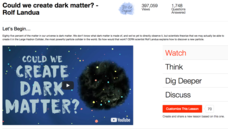Narrator Teacher Resources
Find Narrator lesson plans and worksheets
Showing 2,416 resources
Curated OER
How Social Media Can Make History
From Nineteen Eighty-Four, Brave New World, and Fahrenheit 451 to Facebook, Twitter, and TXT. Here’s a must-see video for anyone interested in the transformation of the media landscape and message distribution. The narrator traces four...
Curated OER
Korean War
If you are looking for a well-produced synopsis on The Korean War, this video could be for you! In just under seven minutes, the narrator takes viewers through the causes of the war, and all of the many twists and turns that occurred;...
Curated OER
SpongeBob's House is Not a Pineapple
Who would have thought we could use SpongeBob as a mathematical example? A fantastically fun video that provokes higher thinking about the reality that SpongeBob's house might not actually be a pineapple based on its relation to the...
TED-Ed
What Percentage of Your Brain Do You Use?
Have you heard that humans only use about 10 percent of their brains? Well, don't believe it! After describing the tremendous amount of energy needed to power our 86 billion densely packed neurons, the narrator also explains how our...
TED-Ed
What is a Fungus?
After watching a short film about the anatomy and physiology of fungi, discuss with your class the seven provided Think questions, or make up your own. The animation is in the style of colorful artistic drawings and text that appears in...
TED-Ed
Poison vs. Venom: What's the Difference?
Did you know that poison and venom are not the same? Both are toxic, but poison must be inhaled, ingested, or absorbed, while venom must be injected into a wound. The narrator explains that some toxic compounds may be used for good, as...
MinutePhysics
Do We Expand With the Universe?
The cat's out of the bag (or off the leash, in this case) regarding the expansion of the universe. In this intriguing episode, the narrator explains that space is expanding, not the objects within it. He also tells how expansion...
MinutePhysics
The Wave/Particle Duality - Part 2
By imagining an electron as a particle of dust in a raindrop, the narrator helps viewers to understand wave-particle duality. Drawings and narration liken it to a particle being guided by a wave. The challenge, however, it to determine...
TED-Ed
The Science of Symmetry
No matter which way you slice it, the definition of symmetry might not be clear. The narrator of the video reflects on its true meaning as shapes, plants, and animals dance onstage for a captivated cartoon audience. Your class will be...
Crash Course
Mitosis: Splitting Up is Complicated
Although you cannot clone yourself, the cells in your body can clone themselves, and, in fact, you wouldn't grow if they didn't! Viewers learn all about this process in a video that explains the difference between the processes of...
Crash Course
Natural Selection
The peppered moth is featured in a video about natural selection. The narrator tells the story of Darwin's theory and then moves on to the principles behind natural selection and the different ways it works. Concepts covered include...
Be Smart
The 12 Days of Evolution - Complete Series!
Scientists believe red hair and pale skin evolved in northern Europe because it helped humans synthesize vitamin D easier than those with more melanin in their skin. Viewers explore many interesting facets of evolution in a...
SciShow
Tardigrades: Adorable Extremophiles
Tardigrades are microscopic organisms (0.5 mm long) with segmented bodies and four pairs of legs, each with four to eight claws. The narrator of this video explores tardigrades, organisms that can survive the most extreme environments...
TED-Ed
Could We Create Dark Matter?
Dark matter makes up 85 percent of our universe. The video explains current scientific research to create and better understand dark matter. The narrator explains the research into the large hadron collider with easily understandable...
TED-Ed
Why Do We Harvest Horseshoe Crab Blood?
If you've ever had an injection, the horseshoe crab protects you from infection! Young marine biologists discover how scientists use the unique physiology of the horseshoe crab in medicine with a thought-provoking video. The narrator...
TED-Ed
The Surprising Cause of Stomach Ulcers
That raging fire in your belly is not necessarily the burrito you had for lunch! Aspiring doctors get an in-depth look at the cause of stomach ulcers with an interesting video. The narrator discusses ulcer treatments of the past, how...
TED-Ed
How Do Fish Make Electricity?
Shocking! Share the story of electric fish with young biologists for a fascinating lesson in specialized cells. The narrator of the video describes how some species of fish generate electric current, differentiates between weakly and...
Physics Girl
Are Perpetual Motion Machines Possible?
As part of a larger series, an informative video introduces the concept of perpetual motion machines and the science proving they don't work. The narrator then shares machines that appear to work and highlights the hidden sources of energy.
Physics Girl
How to Shrink a Quarter with Electricity
Electrocuting metal until it shrinks sounds crazy, but it happens! Part of a larger physics playlist an intriguing video explains how an electromagnet shrinks any metal coin. The narrator discusses the electric and magnetic forces as...
Physics Girl
Avoid Electric Shock Getting Out of a Car!
Can you avoid static shocks? As part of a larger physics series, an electric video explains what a static shock is and why it happens. Then, the narrator offers an idea for reducing your shock when exiting a car. She also includes a few...
Physics Girl
My Dad Was Hit by Lightning (Twice!)
You have a one in a million chance of being struck by lightning—and 90 percent of those who are struck survive! As part of a larger series on physics, the narrator interviews her father who has survived being hit by lightning twice. It...
Physics Girl
What Are Antibubbles?
How can you make bubbles filled with water floating in water? An interesting video introduces antibubbles as part of a larger series about physics. The narrator brings in physics students at different levels, college and PhD, to...
Physics Girl
How Do Touchscreens Work?
Why can't we text when wearing wool gloves? The narrator explains the science behind touchscreens as part of a larger physics series. From sensors to translation, the complex process of sending a simple emoji comes to life.
Howard Hughes Medical Institute
Coral Bleaching
What is coral bleaching? Tackle a trendy topic with a narrated animation. Through a combination of video and illustration, the narrator introduces viewers to a coral reef, then goes inside a coral polyp to show its symbiotic relationship...
Other popular searches
- Point of View Narrator
- Author and Narrator
- Unreliable Narrator
- First Person Narrator
- Identify Narrator
- Identifying the Narrator
- Point of View/narrator
- Omniscient Narrator
- Identify Narrator or Speaker
- Narrators Point of View
- Narrator Mask
- Narrator and Voice

























